The Iberian Disconnection: Madrid-Lisbon Broken Train Line
After 25 years of delay and political neglect, the high-speed line is one of Europe’s biggest railway gaps

© Inês Leote/Mensagem de Lisboa
Nine hours, two transfers, and a lot of patience. That’s what it takes, in the best-case scenario, to travel by train between Madrid and Lisbon. Despite being separated by just 500 kilometers, there is still no high-speed or even direct connection between the two capitals—a promise Spanish and Portuguese leaders have carried since 2003.
In fact, the two cities are worse connected today than in 1881, when the Madrid-Lisbon railway line opened. It is an anomaly within the European Union: Berlin and Warsaw, at a similar distance, are linked by seven daily trains taking about five hours, while Paris and Amsterdam have nearly twenty connections of around four hours. Meanwhile, Madrid and Lisbon lost their last direct connection in 2020, when the Lusitania, a ten-hour overnight train —compared to six hours by car and just 90 minutes by plane—, ceased operations due to lack of profitability.
According to sources consulted by El Orden Mundial and the Portuguese media outlet O Mensagem, the Iberian connection will not be ready by 2030. That was the target set by the European Commission and the Spanish government ahead of the 2030 FIFA World Cup, which Portugal, Morocco, and Spain will host. However, the high-speed train linking both capitals will not enter service until at least 2034, 25 years after the first official promises. This is acknowledged by the European Commission in an implementation plan just published.
Even that date seems unlikely: less than half of the route has been built, and the other half is still pending tendering, including a new bridge over the Tagus river in Lisbon and a controversial viaduct over the same river in Toledo, a city in central Spain, Castile.

lisboa-madrid-ingles
© Álvaro Merino
The Spanish government, via the Commissioner for the Atlantic Corridor, José Antonio Sebastián, “categorically” committed in mid-October this year to have its section of the high-speed line ready by 2030, despite a 200-kilometer segment suffering a political deadlock in Toledo that has lasted nearly two decades. Antonio García, coordinator of Sudoeste Ibérico en Red, the main platform advocating for the connection, accuses the government of lying and says this deadline is “unrealistic.” In his view, the 2034 date is also “hard to believe.”
It has been impossible to obtain a single official statement from the Spanish government on this matter: no representative from the Ministry of Transport or its public companies, Adif and Renfe, responded to El Orden Mundial’s questions. Renfe, Spain’s national railway company, even refused by email to provide further information on a service that simply “is not currently available.” The opinion of the Portuguese government could not be obtained either.
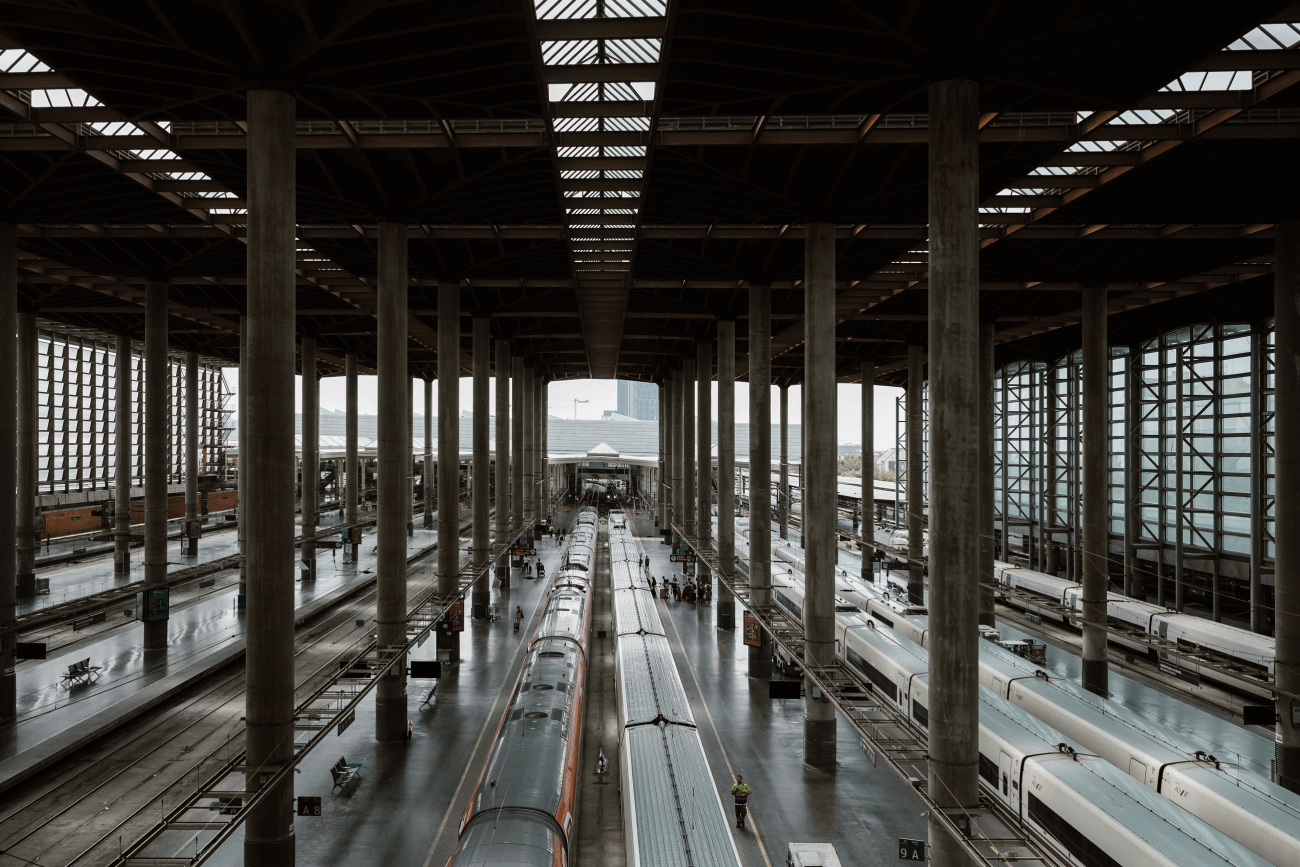
imagen-atocha
Atocha Station (Madrid) / Inês Leote/Mensagem de Lisboa
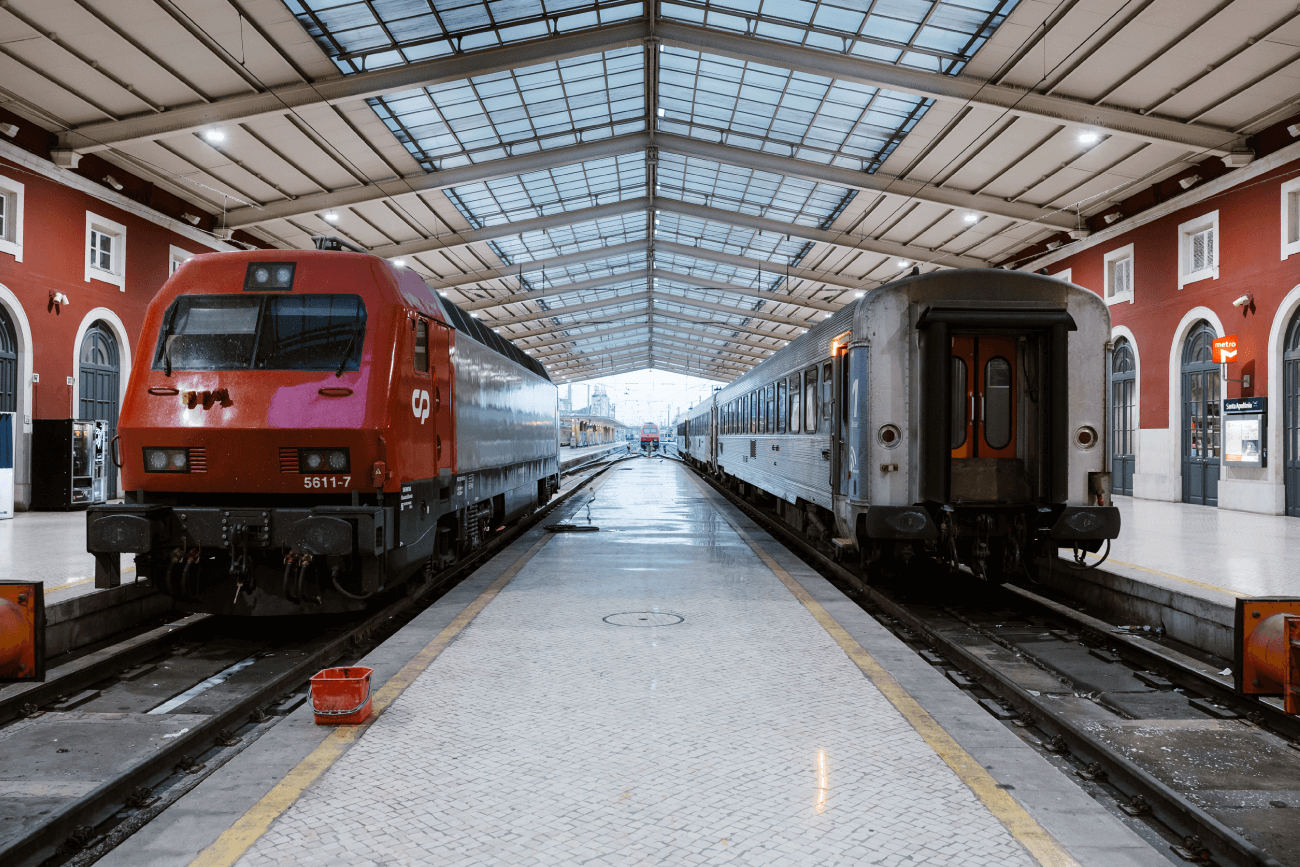
imagen-lisboa
Santa Apolonia Station (Lisbon) / Inês Leote/Mensagem de Lisboa
So what has happened for the border—the “Raya”—to remain impassable by train? The reasons point mainly to Portugal: the European Commission’s document cites “technical and financial limitations” as the main cause of the delay. But the reasons go much further: Lisbon’s fear that Madrid might absorb part of its economic activity, and the prioritization of the Lisbon-Porto-Vigo connection, have resulted in constant ambiguities and script changes that have discouraged a joint effort. Meanwhile, Spain has accumulated significant delays in bringing the AVE —the high-speed train— to the border region of Extremadura, the most neglected area in Spain’s railway system.
The absence of a direct train contrasts with the strong commercial and tourist ties between the two countries. Portugal is the fourth largest destination for Spanish exports—ahead of all of Latin America—while Spain is Portugal’s main trading partner. Meanwhile, tourism between the two countries approached ten million travelers in 2024, and the Madrid-Lisbon route stands out as the second busiest international air connection in Spain, only behind Rome.
Destination: Lisbon
At Atocha Station, the 08:51 train to Badajoz, the first of the morning, is full. It is a Tuesday in August at one of Madrid’s two main railway hubs, and although there are plenty of tourists, the café car soon sparks a heated conversation about rail connections in central and western Iberia: “Is this where the AVE will pass?”
The project to connect Extremadura with a high-speed train dates back to the year 2000. Then Minister of Public Works, Francisco Álvarez Cascos, of the conservative Popular Party, promised that the region would have its own high-speed connection by 2010. It was no arbitrary year: the European Union, always vocal on territorial cohesion and connectivity, had set that limit to establish the Madrid-Lisbon line, which would also provide Extremadura with high-speed connections.
In 2003, the bilateral agreement between the two countries was signed, and construction began the following year. Delays were common from the start, but the 2008 financial crisis, which hit both Iberian countries hard, ultimately derailed the project. Portugal suspended the project in 2011.
Unlike in Spain, where high speed became a symbol of territorial development, trains in Portugal became a taboo—tainted by corruption and a widespread perception of waste associated with socialist Prime Minister José Sócrates’ tenure (2005–2011), especially after the Great Recession. While successive Spanish governments struggled to keep alive conservative President José María Aznar’s 1999 promise to bring the AVE to all provincial capitals, railway plans in Portugal were abandoned.
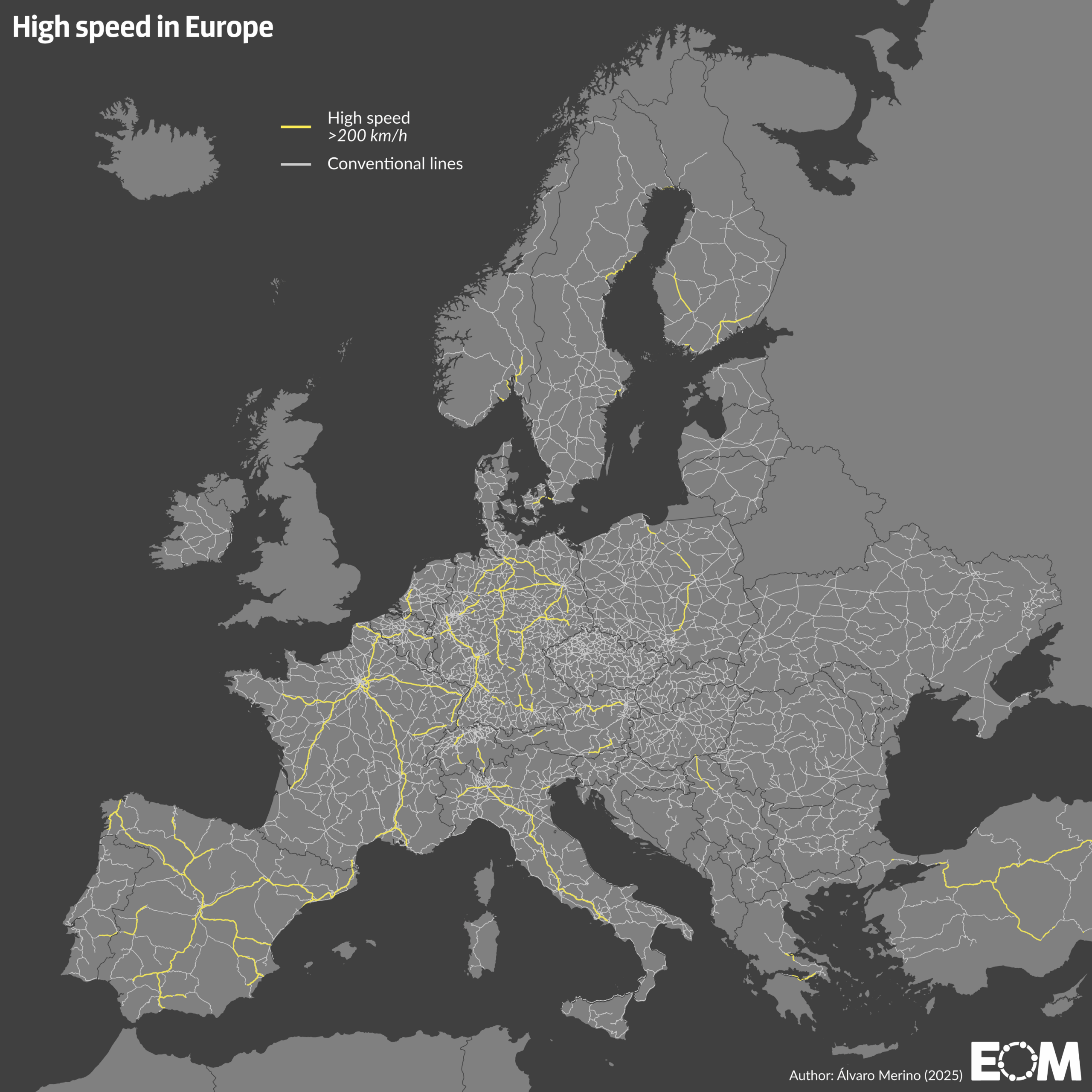
mapa-alta-velocidad-trenes-europa-ingles
© Álvaro Merino
This explains why Spain quickly patched together a solution to prevent the project’s collapse: shortly after taking office, Mariano Rajoy’s right-wing government announced a connection to Extremadura with fast trains in 2015, which also failed to materialize. The same happened with the new promise for the Extremadura corridor in 2019. Under the socialist government, a new target of 2020 also fell through. Finally, these trains began running in 2022, although there is still a long way to go before the AVE promised at the turn of the millennium becomes operational.
The Madrid-Lisbon connection goes beyond the two capitals. Both cities are part of the Atlantic Corridor, a European rail project announced in 2013 to link the Iberian Peninsula with France and Germany and reduce road congestion. With 96% and 86%, respectively, of internal goods transported by road, Spain and Portugal exceed the EU average of 78%. For this reason, Brussels identifies the Madrid-Lisbon connection as “the main missing link” of the Atlantic Corridor.
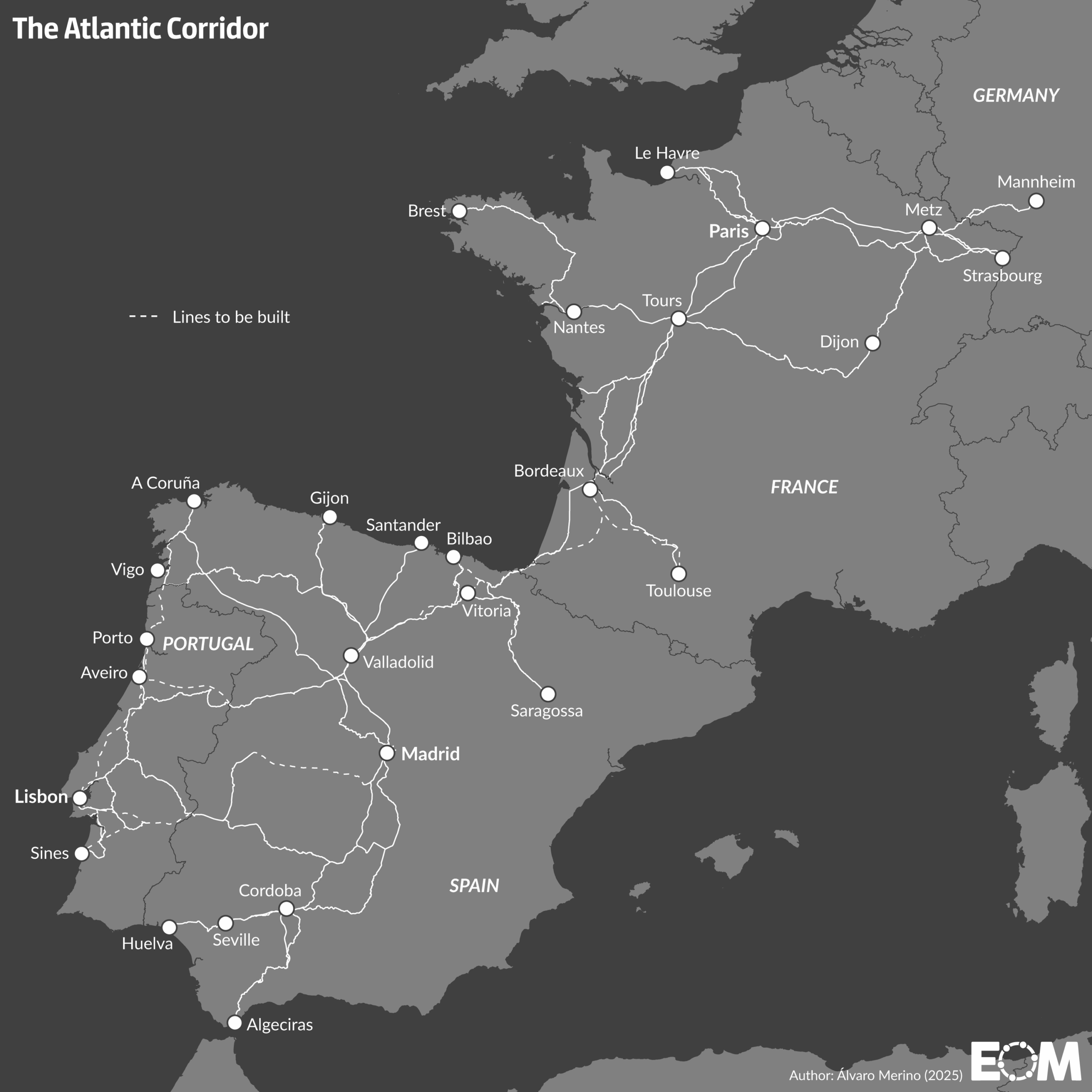
© Álvaro Merino
© Álvaro Merino
Today, the first part of this journey is covered by an Alvia, a hybrid high-speed train that nonetheless links Madrid to Badajoz at an average speed of 105 km/h—Brussels considers 200 km/h the threshold for high speed. Eight trains daily, four in each direction, serve the route, which has ten stops and passes through cities such as Merida, Caceres, Plasencia, and Badajoz, the last station before the Portuguese border.
The journey takes four and a half hours and is essentially a patchwork of all the projects that have dotted the Madrid-Extremadura-Lisbon rail map: unfinished infrastructure, Iberian-gauge tracks, a mix of electrified and diesel trains, and detours to bypass stations incompatible with high-speed service.
The Iberian Peninsula’s complicated topography and the need for more powerful locomotives led to the adoption of tracks wider than the international standard (1,668 mm vs. 1,435 mm) in the 19th century. Spain’s high-speed lines were built with international gauge, but the new Extremadura route and Portuguese high-speed lines have not, preventing integration with the AVE and the rest of the Atlantic Corridor. Moreover, Brussels requires new projects to use the international standard, meaning that at some point, Madrid and Lisbon will have to convert their tracks.
Arriving at Badajoz Station, passengers seek refuge from the 40°C heat outside. “With fewer stops, the trip could take much less time. That’s one reason why there’s such high demand for the AVE, though I think people don’t realize what that means until they experience it, especially because of the prices,” says an Adif worker at the city’s station. She adds that there is strong demand for travel to Lisbon and other parts of Portugal during this time of year.
The Badajoz terminal, inaugurated over half a century ago in the city’s northwest, is just two kilometers from the Portuguese border. The frontier is a vital artery for Extremadura, heavily dependent on social and economic ties with its neighbor. In 2024, Extremadura’s exports to Portugal alone exceeded €900 million, 3.4% of the region’s GDP.
“It’s an unworthy anomaly, contrary to the principles of the European Union,” says Antonio García of Sudoeste Ibérico en Red. Instead of fostering connection and economic development, the lack of a train has turned the border into “a 200-kilometer-wide wall that drives depopulation and low income.”

imagen-atocha-cercanias
The Alvia Train at the Atocha Station / Inês Leote/Mensagem de Lisboa
From Badajoz, it is impossible to reach Lisbon directly. Travelers must first take an old diesel train, built in 1954 and remodeled in 2000, a single-car unit that traverses western Portugal diagonally away from the capital before reaching Entroncamento. The rattling and sense of riding an outdated vehicle persist throughout the nearly three-hour journey, covering 150 kilometers with 17 stops, with locals and tourists boarding and alighting.
Entroncamento is perhaps the historical symbol of the Portuguese rail system. This town of around 20,000 inhabitants emerged in the mid-19th century due to its strategic central location and was named for the centralization of the country’s new rail connections. Its station, a peaceful space dominated by white facades, remains the hub of the national rail network. From there, reaching Lisbon requires an hour-long Intercidades service, which feels like any commuter train in Spain.
Sewing the border
After decades on the shelf, socialist Prime Minister António Costa revived the National Railway Plan in 2022 to develop a high-speed network in Portugal. The good rapport between his administration and that of Pedro Sánchez, of the same political color, allowed progress on the Madrid-Lisbon route, though both leaders could not agree on dates.
While Madrid insisted on 2030, Lisbon spoke of 2032, then 2034, while prioritizing Porto-Vigo first. In May last year, Costa’s successor, conservative Luís Montenegro, finally committed to accelerating the high-speed connection between Lisbon and Madrid and announced the construction of a new Lisbon airport on the south bank of the Tagus, a project pending since 1969.
This step, however, did not come at the expense of the northern link. Lisbon recognizes that the EU prioritizes the capital-to-capital connection and agreed to build both routes simultaneously to qualify for European funding. The recent Brussels decision on Madrid-Lisbon implementation confirms this strategy, targeting 2034 for both routes.
Asked by El Orden Mundial, the European Commission said, “Spain and Portugal are fully committed to completing the connection, and tangible progress is already underway.” It also estimated its funding at €235 million for the Evora-Elvas section and nearly €1 billion for Spain. Yet Portuguese authorities make clear that their priority remains the domestic Atlantic corridor.
Portugal has no high-speed lines in operation, and the Lisbon-Porto-Vigo axis requires a new Linha do Norte. Following Costa’s position, Montenegro emphasized after the 2024 Spanish-Portuguese summit that Galicia is the top priority and Madrid “a secondary priority.” This aligns with the creation of the Galicia-North Portugal Euroregion in 2008, a socially and economically integrated area with heavy traffic. Even a direct Porto-Vigo service operated until this August, when Renfe added with no justification a transfer at Viana do Castelo for the so-called Tren Celta.

imagen-ventanilla
The view from the train window / Inês Leote/Mensagem de Lisboa

19
National Railway Museum in Entroncamento / EOM
Frederico Francisco, a socialist MP and former government transport adviser, adds that the Lisbon-Madrid connection “is not as commercially attractive as it seems.” For him, the 1.9 million passengers in 2024 make it viable by air, but not by train: “Building a new line for only five or six trains a day in each direction is too large an investment.” Francisco believes the Lisbon connection helps Spain justify the costs associated with the AVE to Extremadura.
Beyond political negotiation, construction of the Madrid-Lisboa line has now entered its decisive phase. The Extremadura high-speed axis is nearly complete after electrifying Plasencia-Badajoz in 2023, and the Evora-Elvas section in Portugal is close to completion, which could halve the journey to Lisbon to 90 minutes next year. Works on Plasencia-Talayuela, on the Extremadura-Toledo border, will finish by 2028, shaving off another 30 minutes.
Nevertheless, much remains to be done. The absence of a unified political plan and committed investment has led to multiple subprojects with differing designs and tender processes, leaving loose ends and a patchwork route that makes the 2030 target impossible. Track gauge conversion is pending, as is modernization of Portugal’s outdated signaling system, incompatible with Spain and EU standards. Although Portuguese Rail has developed software to translate its system to the European Train Control System, it is still in testing, with no integration date.
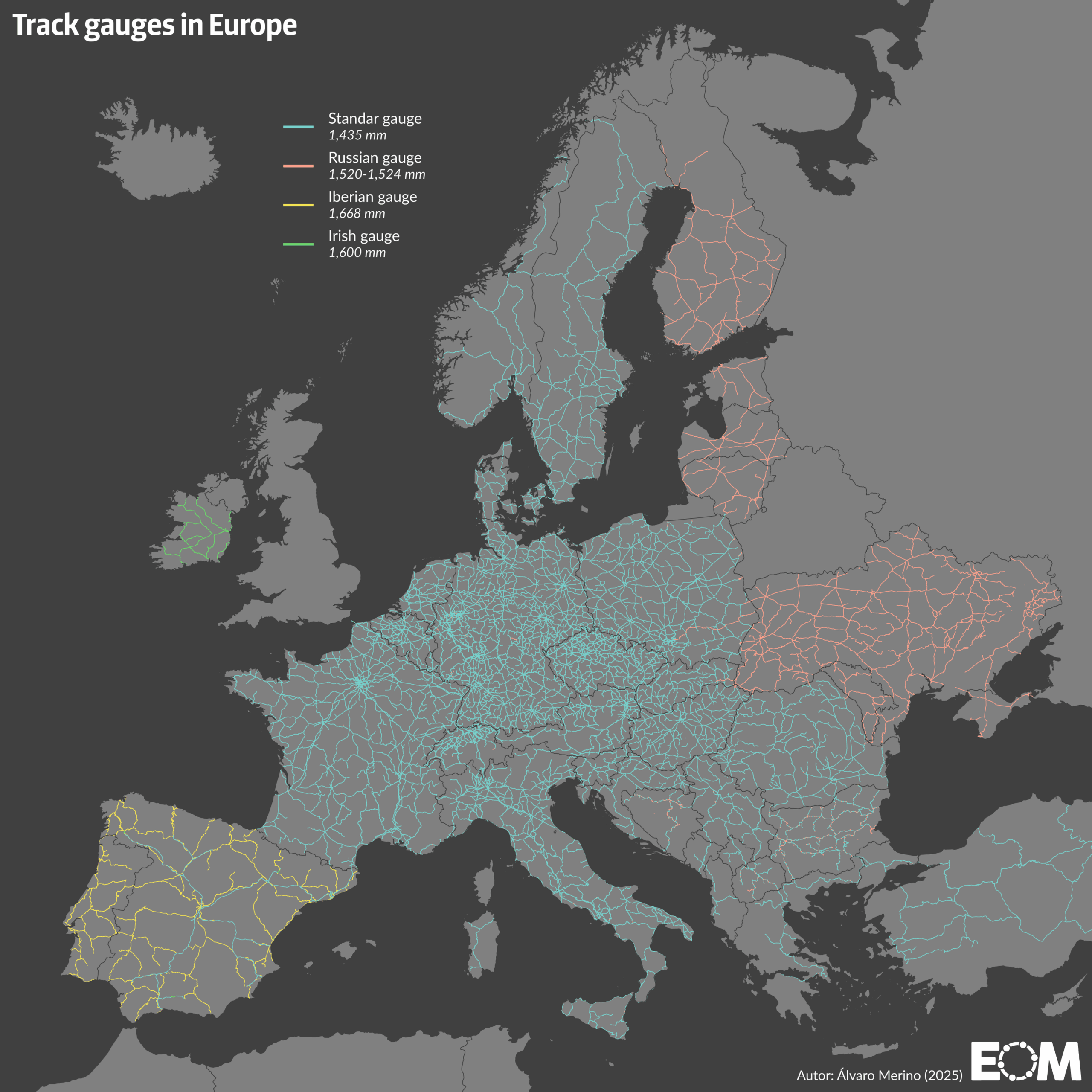
mapa-ancho-via-trenes-europa-ingles
© Álvaro Merino
Meanwhile, the lack of a direct train creates a logistical gap that benefits more polluting modes such as air and road. About 90% of traffic between Spain and Portugal goes by road, according to 2019 cross-border observatory data, plus around forty daily flights and twenty buses. Vinci, the French group, benefits from airport concessions and bridge concessions in Lisbon.
The Iberian disconnection also affects freight. Juan Manuel Martínez, president of the Spanish Transport Association, says signaling problems in Portugal impact goods transport to Lisbon via Huelva/Badajoz or northern Portugal via Galicia. Delays also affect Salamanca-Beira Alta electrification. Atlantic ports like Sines and Leixões, heavily invested in modernization, are hampered, while Mediterranean Spanish ports benefit from reduced competition.
The Tagus river, the final border
The second train from Madrid to Toledo is 30 minutes late. With a scheduled duration of 34 minutes, the delay doubles travel time. But passengers, mostly tourists, pay more attention to their luggage than the clock.
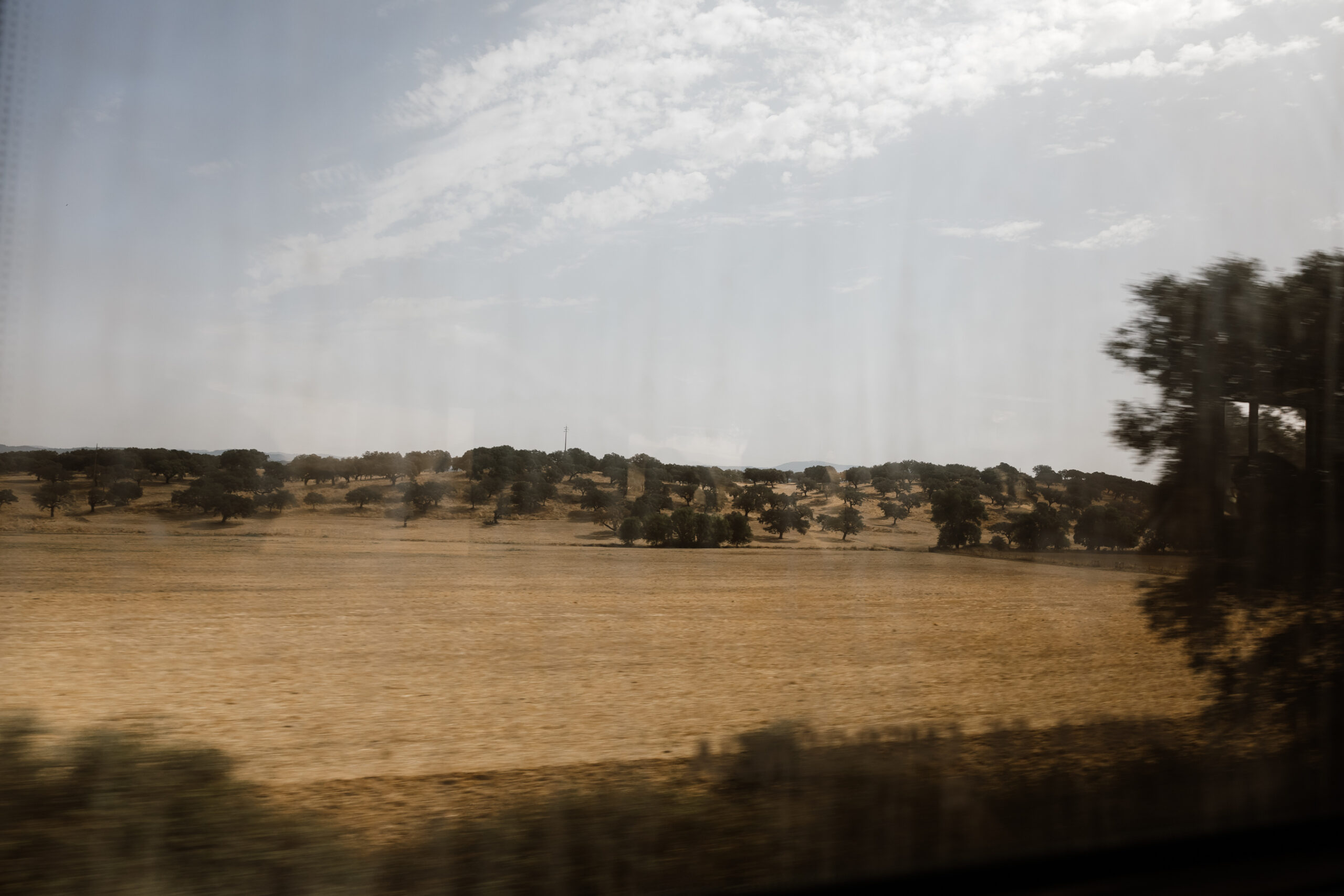
Copia de madrid reportagem ferrovia comboio-0307
A view of the Extremaduran Dehesa from the train / Inês Leote/Mensagem de Lisboa

IMG_8306 Edited
Entroncamento Train Station / Inês Leote/Mensagem de Lisboa
In Toledo, the neo-Mudejar 1919 train station, a cultural heritage site, welcomes over a million tourists a year. The fifteen daily trains from Madrid are usually full. Toledo’s station is terminal: the line ends at the platform. The debate over extending the line to Extremadura has lasted nearly two decades, leaving the Castile-La Mancha capital as the last major obstacle.
The debate revolves around a bridge. The Transport Ministry wants a new span connecting to the current route, which ends two kilometers from the historic center. The regional government prefers a new station outside the city.
Javier Esquinas, spokesperson for Toledo Train Users, warns that the new station would render the historic one obsolete, as happened in Cuenca. He criticizes the regional plan as short-term and self-interested, favoring a station near administrative complexes rather than improving connectivity.
Building the bridge risks Toledo’s UNESCO World Heritage status. In Dresden, Germany, a bridge caused the Elbe Valley’s removal from the list in 2009, though there the project was subject to referendum and traffic only. In Toledo, no design discussions have occurred, and the bridge would parallel an existing road span, ending in a neglected park.
The Alternative to the AVE
Sources indicate that the high-speed obsession has blocked viable alternative connections. Antonio Garcia of Sudoeste Ibérico en Red says a six-hour service with a single transfer in Badajoz could operate next year, but no plan exists. Pau Noy, president of the Iberian Railway Alliance, criticizes the lack of regional services due to “obsession with the AVE.” Once Evora-Elvas is complete, travel time could drop to five hours with fewer stops, and six daily connections could run between capitals, including two overnight reaching Barcelona.
The European plan explicitly calls for an “intermediate phase,” albeit more cautiously: “Direct high-speed services of approximately five hours no later than 2030.”
On the Portuguese side, the Tagus is also the final obstacle. Lisbon has only two congested bridges, insufficient for a new high-speed rail link to Madrid. A third bridge is required, especially now that the new airport’s south-bank location is confirmed. The government aims for a 2031 airport opening and 2034 bridge completion.
However, past delays, differing political priorities, and the scale of pending works temper optimism. Twenty-five years after the first promises, the Lisbon-Madrid high-speed line is closer to another delay than fulfilling the latest official goal.
This article was developed with the support of Journalismfund Europe and in partnership between El Orden Mundial and Mensagem

